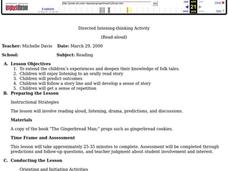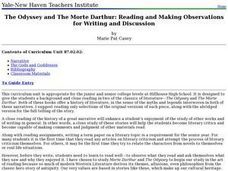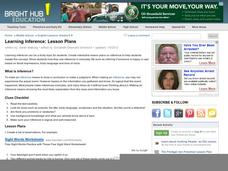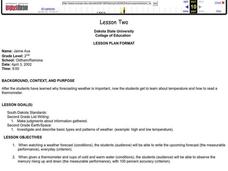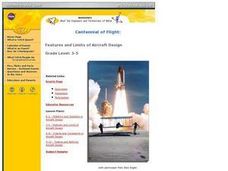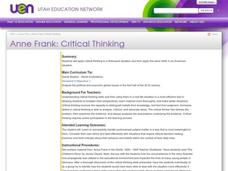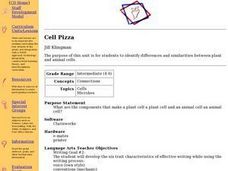Curated OER
Reading
Students are introduced to various types of folk tales. During a read-aloud, they predict what they believe is going to happen next and practice following the story line. To end the lesson, they answer comprehension questions and...
Curated OER
Strawberry Girl: Outdoors in Florida
Students explore nature by researching the state of Florida. In this animal identification lesson plan, students read a children' story and research the Internet to discover the difference in animal life between the early 1900's and...
Curated OER
The Odyssey and The Morte Darthur: Reading and Making Observations for Writing and Discussion
Students read "The Odyssey" and "The Morte Darthur". In groups, they research the gods and goddesses of Greek mythology and the history of the places mentioned in the stories. Individually, they are to write a paper about a hero they...
Curated OER
Learning Inference
Making inferences can be a tricky proposition for middle schoolers. In the lesson presented here, pupils practice the skill of drawing a conclusion and making a judgment - which are what making an inference is all about! There are five...
Curated OER
Lesson Two
Second graders, after assessing why forecasting weather is important, study about temperature and how to read a thermometer. They experiment being able to observe the mercury rising up and down when given a thermometer and cups of cold...
Curated OER
Features and Limits of Aircraft Design
Students identify the desired features of an aircraft and the limits that they, the Wright Brothers, or NASA scientists might face in designing one, and methods to solve these. They review parts of an airplane and what makes it fly. They...
Curated OER
Anne Frank: Critical Thinking
Students read a story by James Clavell about propaganda and they discuss how it was used in the story. In groups, they decide what they would do if faced with certain situations.
Curated OER
Burning Issues
Learners study fire management. In this science lesson, students recognize and understand what they think would be the most responsible and appropriate actions to take in regards to fire managment.
Curated OER
Morphing
Pupils examine how organisms adapt to their environment in order to survive. As a class, they discuss the extinction of the dinosaurs and review Darwin's theory of survival of the fittest. They select an animal to morph in the future and...
Curated OER
It Counts
Students explore how numbers can identify objects. In this math lesson plan, students determine how numbers are used to describe objects used in quantitative data collection.
Curated OER
Cell Pizza
Students identify parts and functions of microscope. Students watch video, Cells and Life about cell parts with actual pictures and actual cells. Students discuss video and identify parts of the cells that animals and plants have in...
Curated OER
Problem-Solving for Employment Barriers
Students examine different employment opportunities and possible barriers that may occur. In this career skills lesson students discuss different barriers and work in groups to overcome these.
Curated OER
Supermarket Science: The King Sooper Lab
Students read product labels, compare fat, sodium, and sugar contents of various food items. They work with a partner and often employ the assistance of the deli and bakery managers in a supermarket.
Curated OER
Social Problems -- Lesson 2
Students in an adult ESL class continue to examine the problems faced by those who live in Africa. In groups, they read an article on the internet and analyze how the people in the country are taking care of the problem of AIDS. They...
Curated OER
Anne Frank: Critical Thinking
Students examine the experience of Anne Frank during the Holocaust. Using the text, they discover how propaganda was used to impact the lives of young people in Germany. They answer discussion questions as a class and relate her...
Curated OER
You Are What You Eat: Chemical Residues and Consumers
Students determine how evidence gained from a simulated test for the presence of pesticide residues can be used to determine risk. They use peas to simulate pesticide residue testing.
